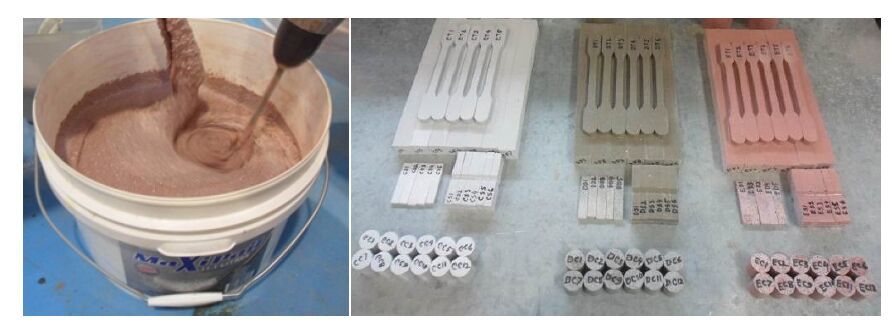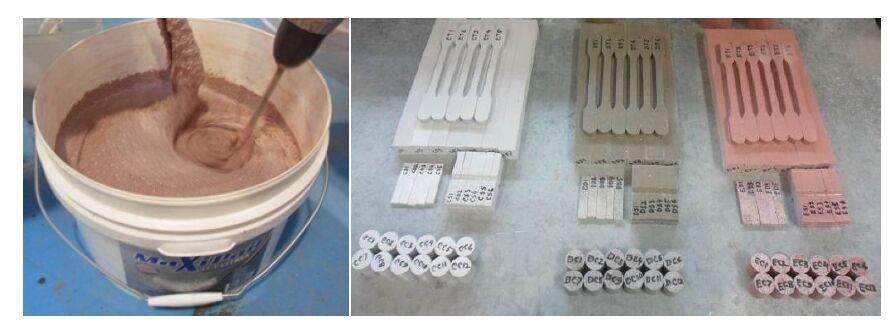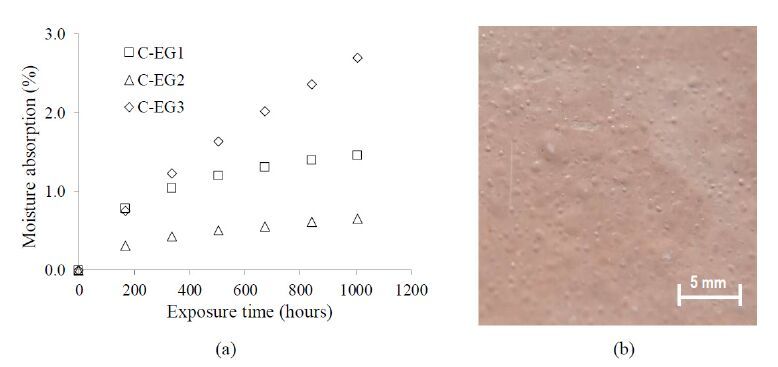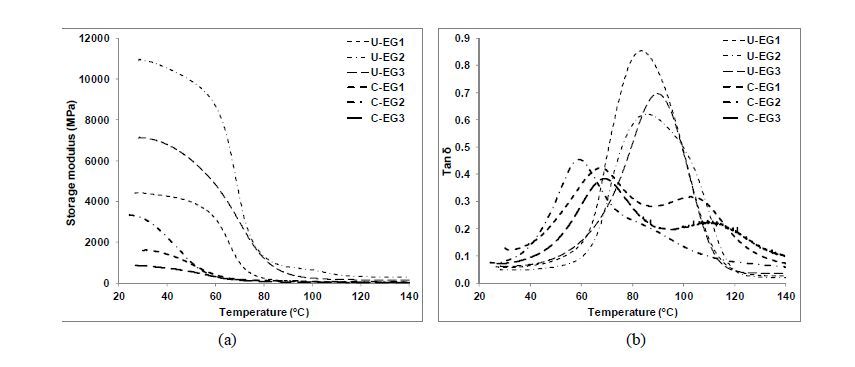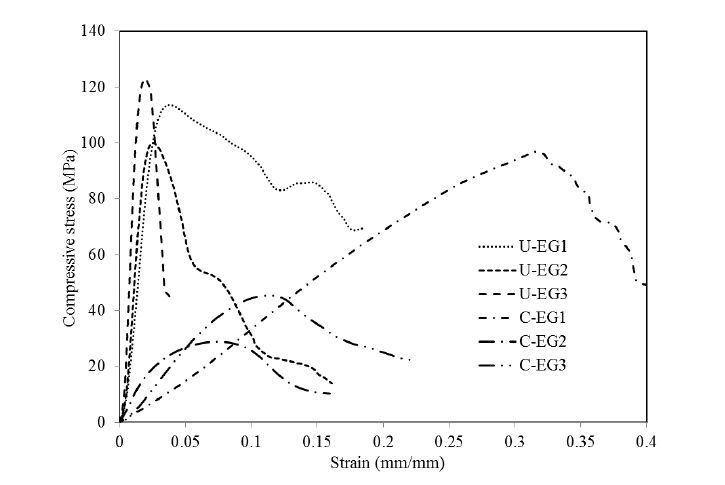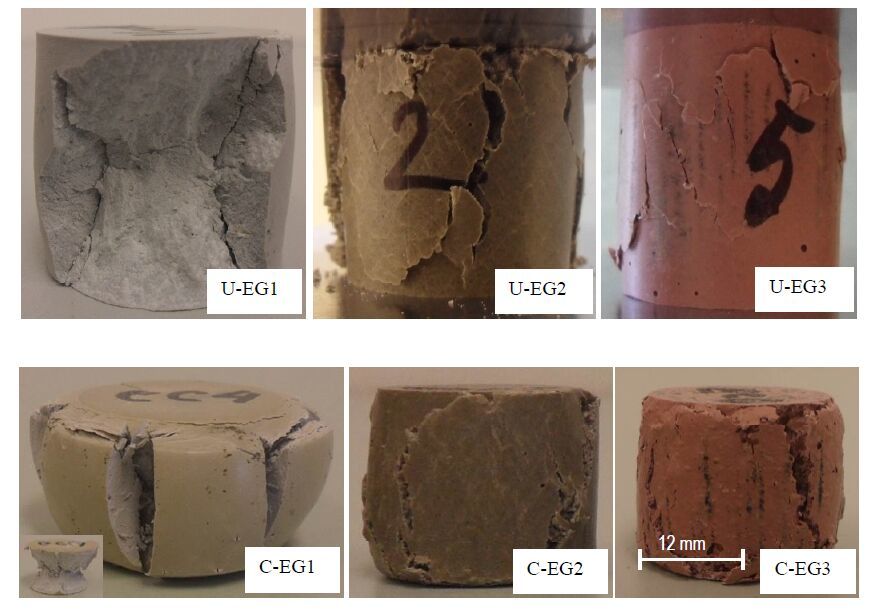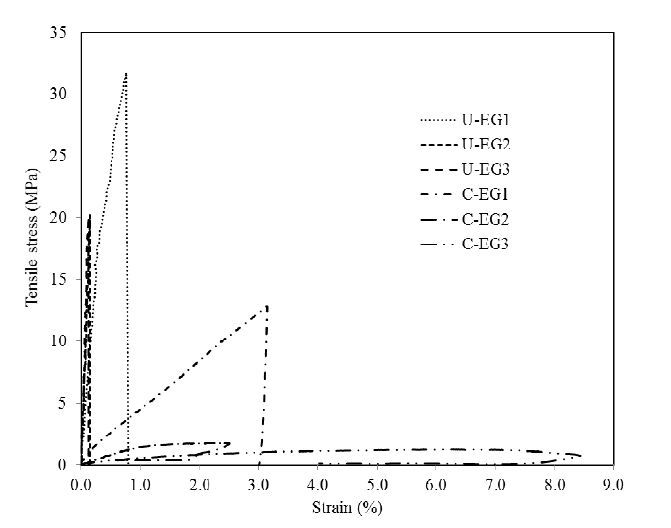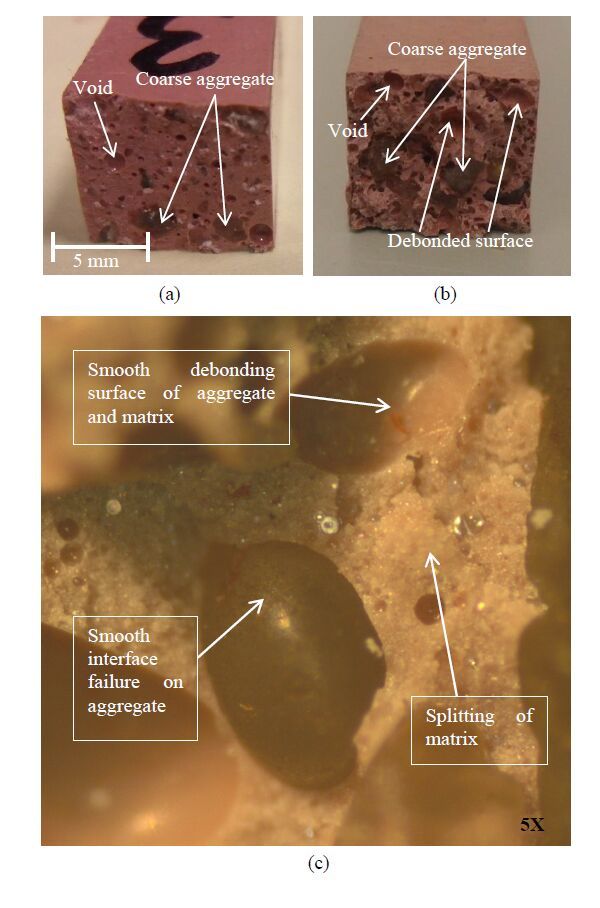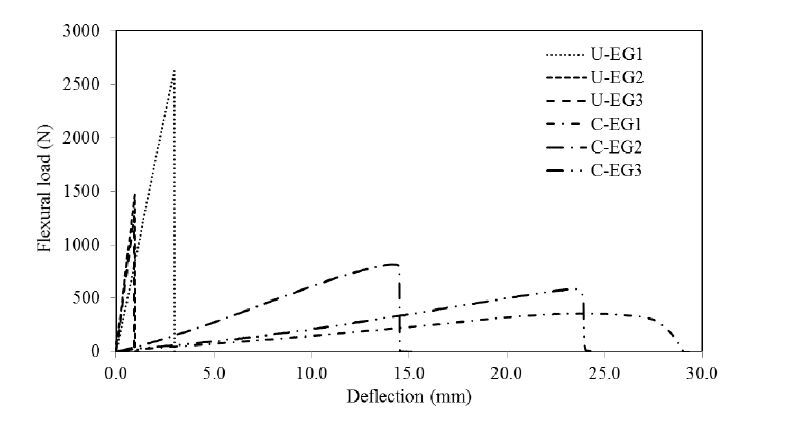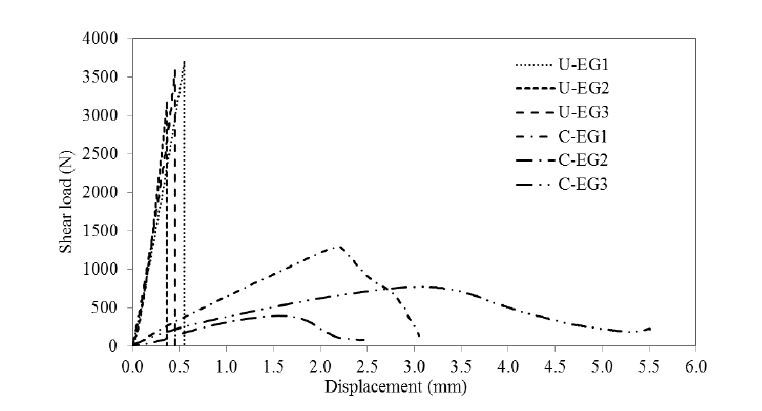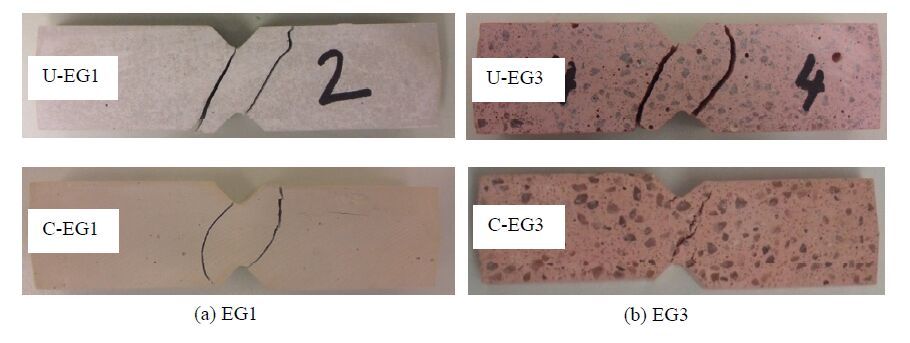1. Introduction
Global energy demand is expected to grow in the next decades and fossil fuels will continue to act as the dominant source of energy all over the world [1,2]. Oil and gas pipes operating for offshore explorations often suffer corrosion due to the harsh marine environment. Infilled polymer composite is considered as a suitable option for rehabilitating metallic structures with metal loss, where annulus between the pipe and the encircling sleeve is filled with a suitable filler material [3,4]. The properties of an infill are critical for the performance of this type of repair, where a filler is necessary for providing smooth surface for effective load bearing [5,6]. Grouts are used as infill in this type of rehabilitation system. Thermoset epoxy resins used in the engineering and industrial fields are the products of copolymerisation of Bisphenol A and epichlorohydrin [7]. Structural grouts derived from epoxy thermoset resins, hardeners and fillers serve as protective layer and effectively transfer load in a repair system. While epoxy grouts are often recommended due to superior properties and ease of application [8,9], limited information are available on the long-term properties of epoxies especially when exposed to harsh environmental conditions including elevated temperature, which are taken into consideration while designing the pipelines [10]. Many studies revealed that fibre composites are durable in harsh environment [11,12]. However, the effect of this extreme condition on the properties of epoxy grouts has received very little attention and needs investigation prior to being selected for structural rehabilitation.
According to ISO/TS 24817, which is a standard used for the qualification of polymer matrix composite pipeline repair materials, “long-term” serviceability of structural rehabilitation of underwater oil and gas pipeline need to be confirmed through 1000 hours of hot-wet conditioning [13]. This standard provides detailed requirements for mechanical and thermal properties of fibre reinforced sleeve, however, it does not present any criteria for the infill grout. It is therefore necessary to investigate the properties to include any grout in the repair system. Long-term performance identification of the grouts should also be carried out for the grouts to find their suitability for long-term offshore applications. Moisture intake for the grouts were also necessary to investigate the saturation state that would provide an insight of the rationality of 1000 hours of conditioning to be termed as long-term in relation to the grouts. Besides, this standard also suggests a temperature range of application considering glass transition temperature as upper ceiling, which should also be investigated. Hence, the effect of elevated temperature and moisture on the properties of three grouts suitable for underwater applications were studied in this paper. A grouted sleeve repair mechanism is such that the infill experiences radial compression, circumferential tension, localised flexing and shear at the defect [5]. For this reason, the compressive, tensile, shear, flexural and thermal properties of these grouts were determined and failure behaviour was observed. Initially, the properties of these grouts were characterised at ambient temperature. Grouts were then subjected to hot-wet conditioning at fresh water under elevated temperature. The investigation of preliminary properties of two of these grouts were partially presented elsewhere [14]. The epoxy grouts are conditioned close to or above their glass transition temperature, thus the limit of their ability to perform structurally in harsh service environments were investigated. This paper reports an extensive comparison of the effect of long term ageing in three epoxy grouts underwater at elevated temperature to assess performance, which is scarce in current available literature.
2. Materials and Method
2.1. Materials
Three epoxy grouts with different specified compositions of neat resin, hardener and aggregate were selected based on their mechanical and thermal properties at ambient temperature. Due to intellectual confidentiality and ease of explanation, the epoxy grouts investigated in this article are designated as grouts EG1, EG2 and EG3, which are expressed as U-EG1, U-EG2, and U-EG3, respectively for unconditioned state, whereas expressed as C-EG1, C-EG2, and C-EG3, respectively for conditioned state. Table 1 provides the mixing ratio and ingredient contents of the different grouts. The first grout, EG1 had parts A and B: high viscous resin with fine filler particles which are already included in the resin part, and low viscous hardener. Whereas, the second grout EG2 had an additional coarse filler including parts A and B: viscous epoxy resin, low viscous hardener, and a combination of coarse and fine filler particles. The third grout was the modification of EG1, which was mixed with the equal weight of coarse filler. The fillers used were calcium and silica based inert fillers.
Table 1.Details of the investigated grouts
| Grouts
|
Part mixing ratio
|
Contents (% Weight)
|
| Resinh
|
Hardener
|
Fine aggregate
|
Coarse aggregate
|
| EG1
|
Aa: Bb = (4.0:1.0)c
|
27.37
|
9.52
|
63.11
|
-
|
| EG2
|
Ad : Bb: Ce = (2.4:1.0:12.0)f
|
15.58
|
6.49
|
77.92
|
| EG3
|
(Aa: Bb): Cg = (4.0:1.0)c:1.0f
|
13.66
|
4.76
|
31.55
|
50.03
|
a Resin with fine filler with particle size of 0.05-300.0 µm, b Hardener, c By volume,
d Resin, e Coarse filler with particle size of 45 µm-2.36 mm,
f By weight, g Coarse filler with particle size of 45 µm-2.36 mm
h Bisphenol A and/or F epoxy resin |
2.2. Specimen preparation
Respective parts of the grout systems were mixed volumetrically and by weight according to the guidelines stated in the respective Technical Data Sheets. A hand held electric drill mixer was used to mix the volumetric batch in a plastic container. Freshly mixed grouts were poured into moulds within their respective allowable mixing periods at 23 °C. Freshly mixed grouts were poured into the designated moulds. Figure 1 shows the mixing of typical grout EG3 and part of the grout specimens. The specimens were cut and polished to the required dimensions. Table 2 summarises the details of specimen dimensions and tests conducted on the prepared specimens. The specimens were removed from the moulds after 24 hours and cured in a controlled environment at 23 °C for 7 days prior to hot-wet conditioning.
Table 2.Summary of test details
| Tests
|
Methods
|
Specimen
|
Nominal Dimension
|
Geometry
|
Loading rate
|
| Compressive
|
ASTM C579
|
5
|
25 mm × 25 mm
|
Cylinder
|
1.3 mm/min
|
| Tensile
|
ASTM D638
|
5
|
10 mm × 10 mm
|
Dog bone
|
1.0 mm/min
|
| Flexure
|
ASTM C580
|
5
|
250 mm × 25 mm × 25 mm
|
Prismatic
|
3.0 mm/min
|
| Shear
|
ASTM D5379
|
5
|
76 mm × 20 mm × 10 mm
|
V-notched
|
1.3 mm/min
|
| Thermal
|
ASTM E1640
|
3
|
60 mm × 12 mm × 5 mm
|
Prismatic
|
1 °C/min
|
2.3. Hot-wet conditioning
The grouts were conditioned by fully submerging in a temperature controlled bath containing fresh tap water. 1000 hours of conditioning was selected to conform to long-term durability criteria for composite materials used for pipeline repairs suggested by ISO/TS 24817. ASTM E1640 provides a number of methods to determine glass transition temperature. Glass transition can be obtained from storage modulus (Tg), loss modulus (Tl) and tan δ (Tt). Investigation on the thermal properties of these unconditioned grouts suggested a Tg range of 53-60 °C, and Tt range of 83-90 °C, which is discussed later in Section 3. According to ISO/TS 24817, the service temperature of a repair component for non-leaking (Type A) and leaking pipes (Type B) should not be 20 °C and 30 °C less than the glass transition temperature Tg, respectively. In this study, Tt is taken as the glass transition temperature ceiling for leaking and non-leaking conditions. Therefore, 70 °C is considered for hot-wet conditioning, which is around the range of 20-30 °C less than the Tt of the unconditioned grouts. The moisture absorption was measured weekly conforming ASTM D 5229.
2.4. Test set up
The compressive, tensile, flexural, shear and thermal properties of the grouts were determined for unconditioned grouts and after 1000 hours of hot-wet conditioning. Table 2 provides with the details of the tests for the grouts. Relevant standards and practices are also shown in the table. All the mechanical characterisation tests were carried out using a 100 kN MTS hydraulic testing machine. The compressive strain was calculated from the crosshead displacement and initial height of the specimen. Figure 2 shows the typical mechanical and thermal testing of the prepared specimens.
A laser extensometer was used to measure the strain data for tensile test. Iosipescu shear test was carried out using shear test fixture by Wyoming Test Fixtures Inc. at negligible normal stresses. The fixture is such that a condition of pure shear was introduced at the middle of the specimen by applying two counteracting moments. The hot-wet conditioned specimens were preheated in a water bath by placing in an oven for at least 30 minutes prior to being placed into the temperature chamber for testing. The test started once the chamber temperature reached 65 °C and was maintained for 10 minutes. The specimens were tested at 65 °C as it was irrelevant to test them at 70 °C, since the glass transition temperatures for the all the conditioned specimens were found below 70 °C. Moreover, this temperature is within the specified temperature range suggested by ISO/TS 24817.
Dynamic Mechanical Analysis (DMA) was used to determine the glass transition temperatures of the grouts as suggested by ISO/TS 24817. A DMA Q800 with Universal Analysis 2000 V5.1 Build 92 manufactured by TA Instruments was used to carry out the tests. The specimens were clamped in the three-point bending fixture of the DMA apparatus with effective span length of 35 mm. Figure 2(f) shows the mounted DMA specimens on the DMA apparatus. The heating rate was 1 °C/min starting from room temperature to 140 °C.
3. Results
3.1. Moisture absorption properties
Figure 3 shows the moisture absorption trend of the grouts over the 1000 hours conditioning period. Moisture content is presented against immersion time in hours. The moisture content is calculated for 25 mm cylindrical specimens. If the moisture absorption of the grouts is compared, the highest absorption is observed for grout EG3 with a value of 2.7% after 1000 hours. The trend suggests that EG1 and EG2 grouts reached equilibrium by 1000 hours. However, an increasing absorption trend in the grout EG3 at 1000 hours indicating that 1000 hours may not be sufficient to achieve complete saturation as suggested by ISO/TS 24817. The lowest absorption is found for grout EG2 with values ranging from 0.66%. The trend of the moisture contents of the grouts suggests that absorption rate is the highest during the first 168 hours (7 days) and decreased thereafter for grouts EG1 and EG2, whereas the absorption increases with time for grout EG3. The behaviour is mostly due to the absorption of water molecules in the intrinsic hole volume [15].
The hot-wet conditioning resulted in a mild change in colour on the surface of the grouts. Most notable physical change occurs on the surface of the grout during the absorption process is the formation of blisters on the surface of grout EG3. Formation of blisters on the grout EG3 is shown in Figure 3(b). This might happen due to the swelling forces of the absorbed moisture which forced out of the surface of the specimen.
3.2. Thermal properties
A superposition of the storage modulus and tan δ is shown in Figure 4. Storage modulus inflexion (Tg) provides lower glass transition than tan δ peak (Tt) for both unconditioned and conditioned grouts. This behaviour is also comparable to Goertzen and Kessler [16]. The conditioned grouts show distinct secondary tan δ peaks. This phenomena related to exposure to higher temperatures is due to the dominant re-arrangement of the molecules resulting in the formation of much denser crosslinking structure [17].
The Tg and Tt in the unconditioned grouts range between 53-59 °C , and 83-90 °C, which range between 39-42 °C, and 59-69 °C, respectively for the conditioned grouts. The highest value of tan δ is observed in the unconditioned grout U-EG3 with a value of 90 °C which is found to be 83 °C for grout U-EG1. On the other hand, the highest value of tan δ peak is also found in the conditioned grout U-EG3 with a value of 69 °C which is about 2 °C higher than that of grout U-EG1. Hence, the lower resin content in grout EG3 does not reduce its glass transition temperature. However, as the storage modulus was recorded from the room temperature, the tangent of the initial storage modulus could not be drawn. Hence, a horizontal line is considered as the initial tangent line which intersects with another tangent line drawn from the decreasing storage onset to determine the Tg.
Table 3.Summary of mechanical and thermal properties of grouts
|
|
Properties
|
EG1
|
EG2
|
EG3
|
| U-EG1
|
C-UG1
|
U-EG1
|
C-UG1
|
U-EG1
|
C-UG1
|
| Compressive
|
Compressive strength (MPa)
|
106.14 (1.35)
|
93.10 (2.47)
|
100.90 (1.29)
|
28.9 (3.55)
|
119.53 (3.48)
|
45.23 (1.85)
|
| Compressive modulus (GPa)
|
5.57 (0.13)
|
0.418 (0.030)
|
7.01 (2.17)
|
0.570 (0.204)
|
10.99 (0.69)
|
0.559 (0.024)
|
| Strain at peak stress (%)
|
3.43 (0.15)
|
31.8 (0.38)
|
2.30 (0.23)
|
7.50 (0.29)
|
1.87 (0.1)
|
11.10 (0.36)
|
| Tensile
|
Tensile strength (MPa)
|
31.97 (3.45)
|
12.22 (1.26)
|
21.20 (1.56)
|
1.66 (0.124)
|
19.14 (0.84)
|
1.29 (0.111)
|
| Tensile modulus (GPa)
|
4.90 (0.81)
|
0.381 (0.075)
|
14.76 (1.99)
|
0.161 (0.005)
|
16.52 (4.68)
|
0.029 (0.004)
|
| Strain at peak stress (%)
|
0.663 (0.10)
|
3.05 (0.71)
|
0.147 (0.02)
|
2.16 (0.25)
|
0.117 (0.03)
|
6.44 (0.62)
|
| Flexural
|
Flexural strength (MPa)
|
53.04 (1.62)
|
8.71 (0.36)
|
34.60 (2.20)
|
18.68 (0.70)
|
34.87 (2.59)
|
12.76 (0.54)
|
| Flexural modulus (GPa)
|
6.15 (0.24)
|
0.120 (0.013)
|
13.02 (0.74)
|
0.529 (0.038)
|
12.81 (0.71)
|
0.203 (0.007)
|
| Shear
|
Shear strength (MPa)
|
29.97 (1.88)
|
10.24 (0.78)
|
25.29 (0.79)
|
3.36 (0.42)
|
28.18 (1.85)
|
6.29 (0.87)
|
| Glass transition
|
Glass transition, Tg ( °C)
|
59
|
39
|
60
|
38
|
53
|
42
|
| Tan δ peak, Tt ( °C)
|
83
|
67
|
85
|
59
|
90
|
69
|
| Values in the parenthesis are standard deviations. |
3.3. Mechanical properties
The mechanical and thermal properties of the unconditioned grouts at 23 °C and conditioned grouts at 65 °C, which were tested at after 1000 hours of hot-wet conditioning at 70 °C are given in Table 3. The average values are presented in the table with standard deviation in the parenthesis. In general, the results show reasonable consistency within individual test groups. For this reason and for clarity of presentation, one representative specimen from each grout is selected for a particular test in this section.
3.3.1. Compressive behaviour
The highest ultimate compressive strength and modulus of the grout U-EG3 are found to be 120 MPa and 11 GPa, respectively. Whereas, grout U-EG2 has the lowest compressive strength and grout U-EG1 has the lowest modulus with a value of 101 MPa and 5.6 GPa, respectively. It is to be noted that grout U-EG3 has the highest filler content compared to other grouts. Hence, grout U-EG3 including coarse filler gains the advantage of attaining higher strength and modulus than that of other grouts. The highest and lowest strengths of the conditioned grouts are found to be 93 MPa, 29 MPa, and 45 MPa for grouts C-EG1, C-EG2, and C-EG3, respectively. Compressive modulus of the grouts are found to be 0.42 GPa, 0.57 GPa 0.56 GPa for grouts C-EG1, C-EG2, and C-EG3, respectively. Hence, C-EG1 has the highest strength and lowest modulus due to its highest resin content and lowest coarse filler.
Figure 5 shows the comparison of the typical compressive stress-strain behaviour of the compressive specimens. The epoxy grouts show an elastic behaviour followed by yield stresses. The relative deformation in the conditioned specimens are clearly much higher compared to unconditioned grouts. The yield strain of U-EG1, U-EG2 and U-EG3 are 3.4%, 2.3%, and 1.9%, respectively, which increased to about 32%, 8%, and 11%, respectively after hygrothermal conditioning.
Figure 6 demonstrates the typical failure patterns of the unconditioned grouts under uni-axial compression. Under compression, grout U-EG1 exhibits peripheral bulging after the initial elastic behaviour. The orientation of cracks in the outer shell of grout U-EG1 is vertical. District cup-and-cone failure is observed for both U-EG1 and C-EG1 specimens. The bulging proceeds until failure which is initiated by vertical cracks. However, the bulging in the C-EG1 in comparatively higher than that of the U-EG1. The failure wedges in the compression specimens form at an angle of about 45° with the vertical axis for both conditions. The bulging starts after the linear elastic zone of the stress-strain curve. However, for the grout U-EG1, following yield and the accompanying reduction in stress, there is an increase in stress, but not beyond the peak stress. This is due to the meeting of the failure wedges at prolonged strain. The cracks in the grouts U-EG2 and U-EG3 specimens are sharp and randomly oriented with no visible wedge. Similar crack pattern is also visible for the C-EG2 and C-EG3 specimens. However, the cracks are more plastic in appearance indicating cohesion in the surface. The failure is governed by crushing and there is negligible lateral expansion and post yield hardening in the grouts U-EG2 and U-EG3. This behaviour can also be observed in the C-EG2 and C-EG3 grouts, where there is slight bulging and no notable post-yield hardening.
3.3.2. Tensile properties
The highest and lowest tensile strengths of the unconditioned grouts are found to be 32 MPa and 19 MPa for the grouts U-EG1 and U-EG3, respectively (Table 3). Conversely, the lowest and highest tensile modulus are calculated 5 GPa and 17 GPa for the grouts U-EG1 and U-EG3. Relatively high standard deviation was observed for the modulus of the unconditioned tensile specimens because of the entrapped bubble within the thin section of the specimens, which is discussed later in this section.
It is evident that the inclusion of coarse filler has contributed to the reduction of the tensile strength of the grout U-EG1. Higher tensile moduli are obtained in grout U-EG2 and U-EG3 with values of about 15 and 17 GPa, respectively, which are about three times higher than that of grout U-EG1 despite of the strength and resin contents in grouts EG2 and EG3 are less than that of grout EG1. This suggests that the inclusion of filler has resulted in increment of stiffness in the grouts U-EG2 and U-EG3. From the table, it can be seen the highest tensile strength and stiffness of the conditioned grouts are found for grout C-EG1 with a values of 12 MPa and 0.38 GPa, respectively. The lowest tensile strength and modulus are found for grout C-EG3 with values of 1.29 MPa and 0.03 GPa, respectively. Hence, there is considerable reduction in properties due to hygrothermal ageing. The tensile strength and stiffness of Grout C-EG3 are about 10 times and 13 times lower, respectively, than those of grout C-EG1.
The comparison of the typical tensile stress-strain behaviour is shown in Figure 7. Unconditioned grout U-EG1 shows relatively prolonged ductile deformation under tensile load exhibiting the highest strength among the grouts. This behaviour may be due to the finer filler in the matrix. Grouts U-EG2 and U-EG3 have moderate strength and the specimens have failed at lower strains than that of grout U-EG1. Conditioned grout C-EG1 shows a linear stress-strain relation exhibiting the highest strength. Grouts C-EG2 and C-EG3 transition to non-linear behaviour almost immediately upon loading, and exhibit very low yield strengths compared to grout C-EG1. The highest failure strain is observed in grout C-EG3. It is to be noted that the tensile strains of the grouts C-EG2 and C-EG3 reverse due to the displacement in the laser reflector tape after the crack formation of the surface of the specimens.
Figure 8 shows the typical failure pattern of the tensile specimens. All the unconditioned grouts fail due to splitting, which are perpendicular to the length. The formation of crack in the grouts is sudden and a splitting sound is heard. An observation that can be made is that voids are present in all three cured grouts. The failure surface of grout EG1 has a smooth appearance in both test conditions. The failure surface of unconditioned specimens exhibit smooth texture. Failure surface of the grout U-EG3 is shown in Figure 8(a), which is also representative of U-EG2. It can be seen from the cracked surfaces of the U-EG3 grout that the failure occurs in the matrix through the aggregates. On the other hand, failures in the C-EG3 grout progress slowly compared to grout C-EG1 and are not perfectly perpendicular to the length or straight along the thickness. The failure surfaces of the grout C-EG3 specimens are similar; they appear jagged and the coarse aggregate fillers are visible as shown in Figure 8(b). The magnified view of the failure surface of the conditioned C-EG3 as given in Figure 8(c) shows that failure occurred in the matrix-aggregate interface unlike the phenomenon in the unconditioned specimens. The interface failure between the resin matrix and the aggregate is due to the effect of hygrothermal conditioning which weaken the interfacial bonding.
3.3.3. Flexural behaviour
Figure 9 shows a comparison of typical the load-deflection behaviour of the grout specimens in flexure. The unconditioned grouts show linear load-deflection behaviour prior to failure. Grout EG1 has the highest flexural strength with a value of 53 MPa. Grout U-EG3 has strength of 35 MPa which is lower than grout U-EG1 due to the addition of coarse filler. The flexural stiffness of grouts U-EG2 and U-EG3 is about 13 GPa which is higher than that of grout U-EG1. Conditioned grouts C-EG2 and C-EG3 also showed linear load-deflection behaviour prior to failure, whereas grout C-EG1 exhibits a brief plateau before failure. Grout C-EG2 exhibits the highest load and least deflection prior to failure while grout C-EG1 exhibits the lowest load and highest deflection. As shown in Table 3, despite the intermediate tensile strength and elastic modulus, grout C-EG2 has the highest flexural strength and flexural stiffness, at 19 MPa and 0.53 GPa, respectively. Grout C-EG1, which shows the highest tensile strength and elastic modulus, exhibits the lowest flexural strength and flexural stiffness. This suggests that flexural stiffness of the grouts are considerably affected by hygrothermal ageing.
The typical failure patterns of the flexural specimens are shown in Figure 10. All unconditioned specimens fail in a brittle manner. The cracks are almost perpendicular to the longitudinal axis for specimens U-EG2 and U-EG3. However, the cracks deviate from its tension zone alignment when they propagate towards compression zone for grouts U-EG1 and compression wedge is formed. Also, inspection of the cracked surface suggests that the failure of the resin matrix propagates through the aggregates. This behaviour is also comparable to the tensile behaviour discussed earlier. On the other hand, all the conditioned specimens undergo considerable deformation before failure as seen from Figure 10(b). The cracks are perpendicular to the length for all conditioned grouts with the compression wedges not apparent from the failure surfaces. Further inspection of the cracked surface revealed that failure of the resin matrix propagates through the resin matrix, and interface of the resin and aggregate. This behaviour is comparable to the tensile failure behaviour of the conditioned specimens.
3.3.4. Shear behaviour
The shear strength of the unconditioned grouts U-EG1, U-EG2 and U-EG3 are 30, 25 and 28 MPa, respectively while the conditioned grouts C-EG1, C-EG2 and C-EG3 are 10 MPa, 3 MPa and 6 MPa, respectively. Hence, the shear strength is affected adversely due to inclusion of filler. Grout C-EG3 exhibits lower shear strength than that of grout C-EG1. Figure 11 shows the relative comparison of load and crosshead displacement of the grouts under shear loading. Grouts U-EG1, U-EG2 and U-EG3 exhibit linear load-displacement behaviour before distinct reduction in load during failure, which is also applicable for C-EG1. However, grouts C-EG2 and C-EG3 show relatively smooth transition in the load-displacement plot during failure.
The failure occurs suddenly after the peak load with no prior warning in all the unconditioned grouts. However, the conditioned specimens undergo considerable deformation prior to failure. The failure is made up of two diagonal cracks and a failure wedge in-between the cracks in the unconditioned grouts as shown in Figure 12. Typically, formation of a shear wedge is observed from one crack running from bottom of the top notch towards the bottom plane surface and the second crack running almost parallel from the top of the bottom notch diagonally towards the top plane surface. Hence, it is evident that the failure in the unconditioned grouts is a combination of shear and tension which was also reported in Iosipescu coupon specimen made of graphite [18]. On the other hand, the conditioned grouts failed gradually after the peak load. The angle of the shear cracks was between 30 and 45°. The failure of the conditioned grout C-EG1 is composed of two diagonal cracks and a failure wedge in-between the cracks is similar to U-EG1. Whereas, the grouts C-EG2 and C-EG3 exhibit one large crack with smaller parallel cracks near the notches at the specimen edges.
4. Discussion
4.1. Evaluation of the grouts
Mendis [7] suggested that, grouts having compressive and tensile strength ranges of 83-97 MPa and 28-48 MPa, respectively have the potential to be used in structural rehabilitation. An epoxy-grouted technology for pipeline repair was described by Vu et al. [19] where the compressive, and tensile strengths specified in that article were 75 and 23 MPa, respectively. Mattos et al. [20] investigated with an alternative repair system, where the lowest compressive strength of the infill materials was 56 MPa. Sing et al. [21] found compressive and tensile strength range 60-88 MPa, and 19-33MPa, respectively. Thus, all the investigated grouts can be used for structural repair. The conditioned grouts EG1 and EG3 have the potential to be used on the similar type of repairs in terms of the compressive performance. Detailed numerical study of grouted sleeve repair using an epoxy grout with modulus of 4 GPa for repairing steel pipe with metal loss suggested that an overall stiffer grout is necessary, especially when grouts are subjected to shrinkage during curing, to minimise the pipe strains [22]. The fact, that there is considerable reduction in the stiffness due to conditioning, suggests that the investigated grouts may not be suitable for pipeline repair at an elevated service temperature of 70 °C. However, According to ISO/TS 24817, the grouts may be suitable at their conditioned state for Class 1 repair for low pressure applications, which has a lower design temperature range (less than 40 °C). Moreover, it should be kept in mind that investigation of the conditioning at relevant temperature specifiedby standard is also necessary to come to such conclusion, even for Class 1 repair. Besides, it is to be noted that a higher conditioning temperature is adopted for this study considering glass transition temperature Tt as the ceiling instead of Tg. Hence, the applicability of these grouts in a grouted sleeve repair system is subjected to further investigation on a case-by-case basis.
4.2. Effect on mechanical properties
Table 4 provides a summary of the percentage reduction of mechanical properties of the hot-wet conditioned grouts compared to the properties of the similar grouts cured at 23 °C for 7 days and tested at room temperature. The comparison suggests considerable reduction of properties among the hot-wet conditioned grouts. The fact that epoxy resins based composites can go through considerable deterioration under hygrothermal conditioning was also reported recently [23,24,25]. The dominant reduction occurs in the stiffness of the grouts. Tensile and flexural moduli of the hot-wet conditioned grout decrease by more than 90% compared to unconditioned grouts. The tensile strength of the grouts EG2 and EG3 are also reduced by more than 90%. As general practice, a minimum temperature of 12 °C for placing and maximum temperature of 82 °C for service condition was suggested for epoxy grouts intended for structural applications, where a higher temperature can lead to higher stiffness and cracking [26]. It is to be noted that this guideline is applicable for elevated temperature only. Studies of silica filled epoxy resin under hot-wet conditioning confirmed that there were reduction in the strength and elastic modulus due to the hydrolysis occurring after the debonding of the filler-matrix interface caused by the absorbed water [22,27].
Table 4.Summary of reduction of the mechanical properties
| Properties
|
% Reduction compared to unconditioned specimens cured for 7 days at 23 °C
|
| EG1
|
EG2
|
EG3
|
| Compressive
|
Compressive strength
|
12.3
|
71.4
|
62.2
|
| Compressive modulus
|
92.5
|
91.9
|
94.9
|
| Tensile
|
Tensile strength
|
61.8
|
92.2
|
93.3
|
| Tensile modulus
|
92.2
|
98.9
|
99.8
|
| Flexural
|
Flexural strength
|
83.6
|
43.8
|
63.4
|
| Flexural modulus
|
98.0
|
95.9
|
98.4
|
| Shear
|
Shear strength
|
65.8
|
86.7
|
77.7
|
The reduction in compressive strength is higher in the coarse aggregate filled grouts (EG2 and EG3) than that of the fine filled grout EG1. Hence, coarse filled system is more susceptible to degradation under hygrothermal conditioning. Grouts EG2 and EG3 show relatively prolonged ductile deformation under tensile load compared to grout EG1. It is evident that the inclusion of coarse filler has contributed to the reduction of the tensile strength as well as stiffness when tested at elevated temperature conditions.
The cracked surfaces of both unconditioned grouts EG2 and EG3 show that the failure occurs in the matrix as shown in Figure 8. On the other hand, it can also be seen that debonding of aggregate and matrix in the conditioned grouts is smooth indicating that interface bonding between aggregate and matrix is weaker than the particle strength of the aggregate. Again, since the matrix itself splits, the resin matrix is weaker than the aggregate particle strength. This behaviour in the conditioned grouts is opposite to the behaviour in unconditioned grouts. Both of these scenario are described in another study [28]. The failure in the unconditioned grouts is such that the individual aggregate strength is higher than both the resin matrix and the interface bond. The possibility is that the aggregate is strong enough to provide sufficient resistance against failure where the failure occurs thorough the resin matrix and the aggregate, provided the matrix is also stronger than the interfacial bonding energy. In contrast, this situation of conditioned grouts especially grouts with coarse filler align with the argument that the resin matrix, and the matrix-interface bond is weaker than the individual aggregate. From a detailed magnified view of grout EG3 shown in Figure 8(c), it can be seen that aggregates does not split due to tensile force. This implies that hot-wet conditioning reduced the strength of the matrix-grout interface of the grouts.
The flexural properties of the unconditioned grout EG1 are found to be higher than that of grout EG2 and EG3. However, the flexural properties of grout EG1 are found to be lower than that of other grouts, whereas tensile properties of grout EG1 are found higher as shown in Table 3. This is due to the fact that conditioned grout specimens soften due to the action of elevated temperature. Hence, tensile crack form at the bottom of the specimens when loaded. Since the crack is formed at the bottom, the top of the specimen goes through compression. Grout EG1 has the highest resin/filler ratio than that of other grouts and provides lower resistance due to softening of the resin in the matrix. Besides, coarse filler is no longer acts as a reinforcement against crack in the conditioned grouts.
4.3. Effect on thermal properties
The tan δ peak, Tt of the conditioned grouts is found to be about 60-70 °C, which is about 20 °C lower than the unconditioned grouts. Again storage modulus, Tg is also reduced by about 20 °C when conditioned. This implies that hot-wet conditioning reduced the glass transition temperature of the grouts. Elevated temperature in conjunction with moisture were found to reduce the glass transition temperature by a range of 9-25 °C, hereby the service temperature in an intensive study on a number of epoxy grouts for structural application [29]. Hence, the mechanical properties are affected by the hot submerged condition (70 °C) and elevated temperature, which is above their glass transition temperature as determined by storage modulus. It is evident that the appropriate glass transition assignment approach used here, taking the peak of the Tan δ curve (Tt), is less conservative approach than taking the onset of decline in the storage modulus (Tg). Furthermore, Tg and Tt are found to reduce by approximately 20 °C after hot-wet conditioning, which for instance justifies the 20-30 °C temperature buffer used for Type A and Type B pipeline repairs, based on the guidelines presented in ISO/TS 24817. Hence, further investigation on the properties is suggested considering the Tg instead of Tt of the unconditioned specimen as benchmark.
5. Conclusion
Three epoxy-based grouts were tested for mechanical and thermal properties at 23 °C. The grouts were also hot-wet conditioned for 1000 hours at 70 °C and tested at 65 °C to observe the effect of elevated temperature hygrothermal conditioning resembling an offshore underwater service environment for pipeline rehabilitation. Compressive, tensile, flexural, shear and glass transition properties were determined. The following conclusions can be drawn from the results:
The average moisture absorption is observed for the grouts within a range of about 0.5-2.7% after 1000 hours, when two of the three grouts achieved saturation, indicating that extended conditioning beyond 1000 hours may be necessary to achieve saturation for specific grout of interest.
The compressive strength and modulus of the investigated grouts range from 100-120 MPa, and 5.6-11.0 GPa, respectively indicating their suitability for structural rehabilitation of offshore pipelines.
The coarse aggregate is found to be effectively contributing against crack in the unconditioned grouts. However, there is reduction of bonding on the aggregate-matrix interface after conditioning, which causes reduction of tensile strength and modulus.
The grouts have experienced reduction in mechanical properties due to elevated temperature moist curing limiting their applicability in a submerged service condition at the elevated temperature of 70 °C, which is close to their glass transition temperature.
The glass transition temperatures, Tg and Tt of the grouts are found to be within a range of 50-60 °C, and 80-90 °C, which are reduced by about 20 °C after conditioning, which confirms that glass transition temperature defines a significant margin for maximum temperature beyond which polymer undergoes considerable reduction in properties under submerged condition.
Acknowledgement
This work was undertaken within P1.3 Deep Water Composites, part of the Cooperative Research Centre for Advanced Composite Structures (CRC-ACS) program, established and supported under the Australian Government’s Cooperative Research Centres Program.
Conflict of Interest
The authors report no conflict of interests in this research.









 DownLoad:
DownLoad: 